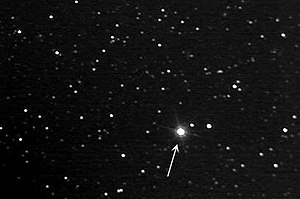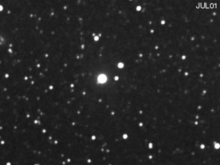Barnard's arrow star
|
Star Barnard's arrow star |
|||||||||||||
|---|---|---|---|---|---|---|---|---|---|---|---|---|---|

|
|||||||||||||
| The arrow shows Barnard's arrow star (photo taken on May 21, 2006) |
|||||||||||||
| AladinLite | |||||||||||||
|
Observation dates equinox : J2000.0 , epoch : J2000.0 |
|||||||||||||
| Constellation | Snake bearer | ||||||||||||
| Right ascension | 17 h 57 m 48.5 s | ||||||||||||
| declination | + 04 ° 41 ′ 36.1 ″ | ||||||||||||
| Apparent brightness | 9.51 mag | ||||||||||||
| Typing | |||||||||||||
| B − V color index | +1.73 | ||||||||||||
| U − B color index | +1.26 | ||||||||||||
| R − I index | +1.56 | ||||||||||||
| Spectral class | M4 Ve | ||||||||||||
| Variable star type | BY | ||||||||||||
| Astrometry | |||||||||||||
| Radial velocity | (−110.6 ± 0.2) km / s | ||||||||||||
| parallax | (547.45 ± 0.29) mas | ||||||||||||
| distance | (5.958 ± 0.003) Lj (1.827 ± 0.001) pc |
||||||||||||
| Visual absolute brightness M vis | (+13.3 ± 0.1) mag | ||||||||||||
| Proper movement | |||||||||||||
| Rec. Share: | (−802.803 ± 0.638) mas / a | ||||||||||||
| Dec. portion: | (+10362.542 ± 0.360) mas / a | ||||||||||||
| Physical Properties | |||||||||||||
| Dimensions | (0.160 ± 0.003) M ☉ | ||||||||||||
| radius | (0.194 ± 0.006) R ☉ | ||||||||||||
| Luminosity |
0.00044 L ☉ |
||||||||||||
| Rotation time | 130.4 d | ||||||||||||
|
Other names and catalog entries |
|||||||||||||
|
|||||||||||||
Barnard's Arrow Star (or Barnard's Star ) is a small star in the Serpent Bearer constellation . At a distance of about 6 light years , Barnard's arrow star is the fourth closest of the known stars to the solar system . Only the three components of the α-Centauri system are closer. However, the arrow star is a red dwarf with a spectral type M4 and an apparent magnitude of 9.54 mag, so that despite its proximity it shines too weakly to be observed without a telescope or powerful prism binoculars . It is near the star 66 Oph . By the year 11,800 it will approach the Sun within 3.8 light years and then move away again.
Fast runner
Barnard's arrow star has a proper movement of 10.4 arc seconds per year, which corresponds to an apparent moon diameter in about 180 years. This is currently the largest known proper motion of a star. It was discovered in 1916 by the astronomer Edward Emerson Barnard . Previously, Kapteyn's star in the Pictor (southern sky) had the largest known proper motion of all stars. Such stars, the position of which in the sky shifts remarkably quickly, are called fast-moving stars .
The relative speed of Barnard's arrow star to the solar system is around 140 kilometers per second. The animation shows how fast Barnard's star moves over a period of nine years.
Possible planets
In 1938, a series of photo plates of the star began to be produced at the Sproul Observatory in order to measure its parallax and secular acceleration more precisely and to search for potential companions of the star. For many years from 1963 onwards, a large number of astronomers accepted Peter van de Kamp's claim that he had discovered a perturbation in the proper motion of the arrow star, from the fact that the star was from one or two planets with a mass comparable to that of Jupiter will be circled.
George Gatewood was unable to detect the planet or planets during measurements at the Allegheny Observatory (until 1973). Even so, the theory of planets around Barnard's arrow star persisted into the 1980s, when van de Kamp's claim was generally viewed as flawed. The reason for the inaccuracy of van de Kamp's results were initially undetected errors in the measuring instrument used.
As long as the claim was accepted, it contributed to the star's fame in the science fiction community; For example, it is part of the plot of the television series Moon Base Alpha 1 . It also made Barnard's arrow star appear as a promising target for the Daedalus project , the planning of an interstellar space probe .
In November 2018, an analysis of radial velocity data collected over 20 years , which researchers from the Institute for Astrophysics at the Georg-August-Universität Göttingen had carried out together with an international research team, concluded that there was a possible exoplanet "Barnard's Star b". It is a super-earth with a minimum mass of 3.2 earth masses that orbits the star at a distance of 0.4 astronomical units within 233 days. The authors of the publication are “99% confident that the planet is there.” It may be possible to confirm the planet using the astrometric method (determining the movement of the star around the common center of gravity) using the data obtained by 2020 from the Gaia mission , optical observation with the large telescopes to be completed in the 2020s also appears possible.
Web links
- Article about Barnard's Arrow Star, solstation.com (English)
- ARICNS 4C01453 (detailed data table for Barnard's Arrow Star , English, accessed February 1, 2013).
- Wolfgang Vollmann: Barnards Pfeilstern (accessed February 1, 2013)
- Hipparcos - High-Proper Motion Stars
- mpia: A cold super earth in our neighborhood November 14, 2018
Individual evidence
- ↑ a b c d e Gaia data release 2 ( Gaia DR2 ), April 2018.
- ↑ a b c d Barnard's Star. In: SIMBAD . Center de Données astronomiques de Strasbourg , accessed September 16, 2018 .
- ^ J. Davy Kirkpatrick, Donald W. McCarthy: Low mass companions to nearby stars: Spectral classification and its relation to the stellar / substellar break. In: The Astronomical Journal. Vol. 107, No. 1, 1994, pp. 333 ff. Bibcode : 1994AJ .... 107..333K .
- ↑ V2500 Oph. In: VSX. AAVSO , accessed September 16, 2018 .
- ↑ Pulkovo radial velocities for 35493 HIP stars.
- ↑ a b P. E. Kervella, F. Arenou, F. Mignard, F. Thévenin: Stellar and substellar companions of nearby stars from Gaia DR2. Binarity from proper motion anomaly . In: Astronomy & Astrophysics . 623, p. A72. arxiv : 1811.08902 . bibcode : 2019A & A ... 623A..72K . doi : 10.1051 / 0004-6361 / 201834371 .
- ↑ Göttingen researchers discover new planets . On ndr.de from November 15, 2018.
- ^ I. Ribas, M. Tuomi, A. Reiners, RP Butler, JC Morales: A candidate super-Earth planet orbiting near the snow line of Barnard's star . In: Nature . tape 563 , no. 7731 , November 2018, ISSN 0028-0836 , p. 365–368 , doi : 10.1038 / s41586-018-0677-y ( nature.com [accessed November 14, 2018]).
- ↑ ESO press release: Super-Earth orbits Barnard's star. ESO , November 14, 2018, accessed November 14, 2018 .
- ↑ Rodrigo F. Díaz: A key piece in the exoplanet puzzle. In: Nature 563, 329-330 (2018). November 14, 2018, accessed November 17, 2018 . , doi : 10.1038 / d41586-018-07328-7
